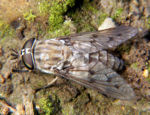- Also known as the horse bot fly
- Obligate parasites of equids
- Spend most of life cycle in the equine stomach
- Of little pathogenic significance
- Three important species (in the UK)
- G. intestinalis which is the most common
- G. nasalis
- G. haemorrhoidalis which is rare
- Two other important veterinary species
- G. nigricornis
- G. inermis
Recognition
- Medium to large flies at 10-20mm long
- Look similar to drone bumble bees
- Body covered with dense yellow hair
- Dark coloured hairs produce a banding pattern
- Clear wings with brown patches
Life cycle
- Adults are most active in late summer
- Eggs are laid on the body and hatch spontaneously or are stimulated to hatch through an increase in warmth and moisture from the animal self-grooming. They are laid in different areas according to species
- G. intestinalis eggs are laid in the hair of the shoulders and fore legs
- G. nasalis eggs are laid in the intermandibular area
- G. haemorrhoidalis eggs are laid around the lips
- Creamy-white eggs
- 1-2mm in length
- Larvae crawl into the mouth and penetrate the tissues of the tongue and buccal mucosa
- Larvae then emerge after a couple of weeks and are swallowed
- Larvae pass into the stomach and attach to the gastric mucosa
- Larvae are now known as bots
- Each species attaches to a specific part of the stomach
- G. intestinalis attaches to the cardiac region
- G. nasalis attaches to the pylorus
- After 10-12 months in the stomach, the larvae detach and are passed out in the faeces
- G. haemorrhoidalis attaches to the rectal mucosa before being passed out
- Larvae pupate on the ground
- Adults hatch after 1-2 months and survive from a few days to 2 weeks
- Adults have non-functional mouthparts so cannot feed
- There is only 1 generation per year in temperate regions of the world
Pathogenesis
- Adults cause annoyance when egg laying
- Disturbance and panic can ensue
- Larvae cause a marked inflammatory reaction when attached to the gastric mucosa
- Ring like thickening around the base of each attached larvae
- Large numbers of larvae may interfere with the passage of food and action of gastric sphincters
- G. haemorrhoidalis can cause mild irritation to the rectal wall
- Host reaction to larvae in the mouth is minimal
Control
- Treatment of horses with insecticides over winter
- Breaks the life cycle as all the population are present as bots in the stomach
- If eggs are present in late summer, the horse's coat can be sponged with an insecticide
- Stimulates hatching
- Kills larvae
